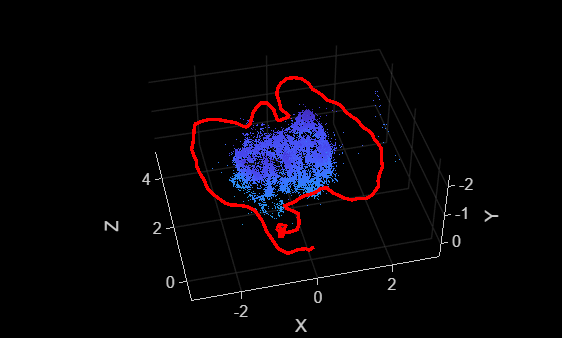hasNewKeyFrame
Description
Examples
Perform RGB-D visual simultaneous localization and mapping (vSLAM) using the data from the TUM RGB-D Benchmark. You can download the data to a temporary directory using a web browser or by running this code:
baseDownloadURL = "https://vision.in.tum.de/rgbd/dataset/freiburg3/rgbd_dataset_freiburg3_long_office_household.tgz"; dataFolder = fullfile(tempdir,"tum_rgbd_dataset",filesep); options = weboptions(Timeout=Inf); tgzFileName = dataFolder+"fr3_office.tgz"; folderExists = exist(dataFolder,"dir"); % Create a folder in a temporary directory to save the downloaded file if ~folderExists mkdir(dataFolder) disp("Downloading fr3_office.tgz (1.38 GB). This download can take a few minutes.") websave(tgzFileName,baseDownloadURL,options); % Extract contents of the downloaded file disp("Extracting fr3_office.tgz (1.38 GB) ...") untar(tgzFileName,dataFolder); end
Create two imageDatastore objects. One to store the color images and the other to store the depth images.
colorImageFolder = dataFolder+"rgbd_dataset_freiburg3_long_office_household/rgb/"; depthImageFolder = dataFolder+"rgbd_dataset_freiburg3_long_office_household/depth/"; imdsColor = imageDatastore(colorImageFolder); imdsDepth = imageDatastore(depthImageFolder);
Select the synchronized pair of color and depth images.
data = load("rgbDepthPairs.mat");
imdsColor=subset(imdsColor, data.indexPairs(:, 1));
imdsDepth=subset(imdsDepth, data.indexPairs(:, 2));Specify your camera intrinsic parameters, and use them to create an RGB-D visual SLAM object.
intrinsics = cameraIntrinsics([535.4 539.2],[320.1 247.6],[480 640]); depthScaleFactor = 5000; vslam = rgbdvslam(intrinsics,depthScaleFactor);
Process each pair of color and depth images, and visualize the camera poses and 3-D map points.
for i = 1:numel(imdsColor.Files) colorImage = readimage(imdsColor,i); depthImage = readimage(imdsDepth,i); addFrame(vslam,colorImage,depthImage); if hasNewKeyFrame(vslam) % Query 3-D map points and camera poses xyzPoints = mapPoints(vslam); [camPoses,viewIds] = poses(vslam); % Display 3-D map points and camera trajectory plot(vslam); end % Get current status of system status = checkStatus(vslam); % Stop adding frames when tracking is lost if status == uint8(0) break end end

Once all the frames have been processed, reset the system.
while ~isDone(vslam) plot(vslam); end

reset(vslam);
Perform RGB-D visual-inertial SLAM using the data from the OpenLORIS-Scene Dataset. Download the data to a temporary directory using a web browser or by running this code:
dataFolder = fullfile(tempdir,"OpenLORIS-Scene",filesep); downloadURL = "https://ssd.mathworks.com/supportfiles/shared_nav_vision/data/OpenLORIS-Scene_corridor1-4.zip"; zipFileName = dataFolder+"corridor1-4.zip"; if ~isfolder(dataFolder) mkdir(dataFolder); disp("Downloading corridor1-4.zip (1.13 GB). This download can take a few minutes."); options = weboptions('Timeout', Inf); websave(zipFileName, downloadURL, options); unzip(zipFileName, dataFolder); end
Create two imageDatastore objects. One to store the color images and the other to store the depth images.
imageFolder = fullfile(dataFolder,"OpenLORIS-Scene_corridor1-4"); imdsColor = imageDatastore(fullfile(imageFolder,"color")); imdsDepth = imageDatastore(fullfile(imageFolder,"aligned_depth"));
Load the IMU measurements data and the camera-to-IMU transform.
data = load("corridor4_IMU_data.mat");
gyro = data.gyroDataCell;
accel = data.accelDataCell;
cam2IMU = data.cam2IMU;Specify the camera intrinsics, the IMU parameters, and use them to create an RGB-D visual-inertial SLAM object.
% Camera intrinsic and IMU parameters can be found in the downloaded % sensors.yaml file intrinsics = cameraIntrinsics([6.1145098876953125e+02, 6.1148571777343750e+02],... [4.3320397949218750e+02, 2.4947302246093750e+02], [480, 848]); imuParams = factorIMUParameters(AccelerometerBiasNoise=2.499999936844688e-05*eye(3),... AccelerometerNoise=0.00026780980988405645*eye(3),... GyroscopeNoise=1.0296060281689279e-05*eye(3),... GyroscopeBiasNoise=2.499999993688107e-07*eye(3),... SampleRate=250); depthScaleFactor = 1000; vslam = rgbdvslam(intrinsics, depthScaleFactor, imuParams, SkipMaxFrames=10,... CameraToIMUTransform=cam2IMU, TrackFeatureRange = [30, 150], DepthRange= [0.1, 6.5], ... NumPosesThreshold=20, MaxNumPoints=1.2e3);
Process image data and IMU data, and visualize the camera poses and 3-D map points.
for i = 1:numel(imdsColor.Files) colorImage = readimage(imdsColor,i); depthImage = readimage(imdsDepth,i); addFrame(vslam, colorImage, depthImage, gyro{i}, accel{i}); if hasNewKeyFrame(vslam) plot(vslam); end end
Once all the frames have been processed, reset the system.
while ~isDone(vslam) if hasNewKeyFrame(vslam) ax = plot(vslam); end end view(ax, 0, 90)

reset(vslam);
Input Arguments
RGB-D visual SLAM object, specified as an rgbdvslam object.
Output Arguments
New key frame status, returned as a logical 0
(false) or 1 (true). A value
of true indicates that a new key frame has been added within the
RGB-D visual SLAM object vslam. A value of false
indicates that no new key frame has been added. The object considers an image frame to
be a key frame if the number of tracked feature points in the current frame satisfies
one these conditions:
The number of tracked feature points is within the limits specified by the
TrackFeatureRangeproperty of thergbdvslamobjectvslam.The number of tracked feature points is greater than the upper limit specified by the
TrackFeatureRangeproperty of thergbdvslamobjectvslam, and the number of skipped frames since adding the last key frame equals the value of theSkipMaxFramesproperty ofvslam.
The hasNewKeyFrame object function returns
true only when the rgbdvslam object has added one
or more new key frames since the last hasNewKeyFrame call. For
example, if the rgbdvslam object adds only one key frame, then two
consecutive calls to hasNewKeyFrame return true
and false, respectively.
Version History
Introduced in R2024a
MATLAB Command
You clicked a link that corresponds to this MATLAB command:
Run the command by entering it in the MATLAB Command Window. Web browsers do not support MATLAB commands.
웹사이트 선택
번역된 콘텐츠를 보고 지역별 이벤트와 혜택을 살펴보려면 웹사이트를 선택하십시오. 현재 계신 지역에 따라 다음 웹사이트를 권장합니다:
또한 다음 목록에서 웹사이트를 선택하실 수도 있습니다.
사이트 성능 최적화 방법
최고의 사이트 성능을 위해 중국 사이트(중국어 또는 영어)를 선택하십시오. 현재 계신 지역에서는 다른 국가의 MathWorks 사이트 방문이 최적화되지 않았습니다.
미주
- América Latina (Español)
- Canada (English)
- United States (English)
유럽
- Belgium (English)
- Denmark (English)
- Deutschland (Deutsch)
- España (Español)
- Finland (English)
- France (Français)
- Ireland (English)
- Italia (Italiano)
- Luxembourg (English)
- Netherlands (English)
- Norway (English)
- Österreich (Deutsch)
- Portugal (English)
- Sweden (English)
- Switzerland
- United Kingdom (English)